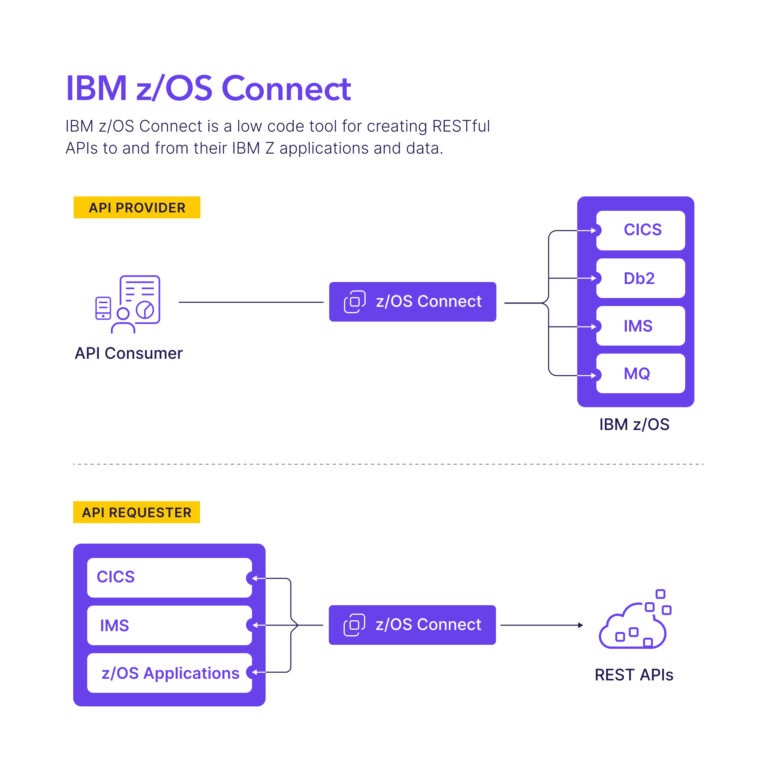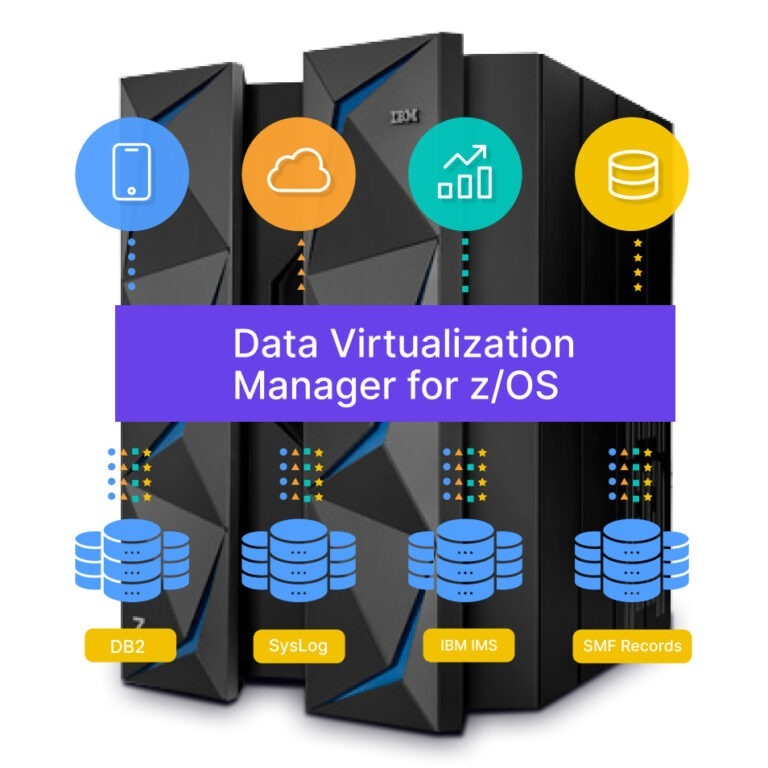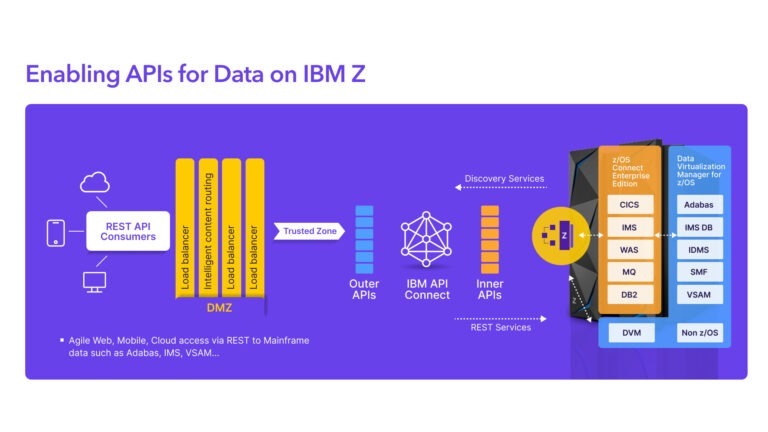APIs and Abstraction: Modernizing with IBM’s z/OS Connect and Data Virtualization Manager

Travis Biro
Senior Product Manager - Mainframe
At Ensono, we’re seeing a a growing trend among clients looking for more ways to modernize access to their mainframe data. Connecting their mainframe toward this goal. However, modernizing these systems and integrating them with cloud services is not without its challenges. Among other things, it requires modernizing applications and their access to data on the mainframe. In many mainframe shops, accessing and integrating mainframe data with other sources and applications can be a complex and daunting task, particularly when using cloud-based technologies.
How business can meet the challenge
IBM offers two products that can help you connect, transform, and virtualize your mainframe data: IBM z/OS Connect and IBM Data Virtualization Manager for z/OS. How do you know which one is right for your needs? Can you use them together for even better results?
To answer these questions, I consulted with the IBM product teams of both products to explain the features, benefits, and use cases of their solutions. Their valuable insights can help you identify the best path forward on your modernization journey.
What is the primary purpose and value proposition of these two products?
IBM z/OS Connect is software that enables you to define and expose RESTful APIs to and from your mainframe applications and data. It allows you to leverage the power and security of your mainframe in a modern and agile way and to integrate it at speed with cloud, mobile, and web applications by creating RESTful APIs in minutes.
IBM Data Virtualization Manager for z/OS is software that enables you to access and join data from multiple sources, including mainframes, without moving or copying the data. It allows you to create a virtual data layer that abstracts the complexity and heterogeneity of your data sources, and to deliver the data in the format and structure that your users and applications need. The applications that need to access the data can run on most operating system platforms.
What are the typical use cases and scenarios for each product?
IBM z/OS Connect is ideal when you need to expose your mainframe data and logic as APIs and to consume APIs from other sources.

- Example: Any given line of business within an enterprise could create a mobile app that interacts with its mainframe transactions or integrate existing mainframe data with a cloud-based analytics platform.

- Example: You can use it to create a view of your customer data from different systems or to provide a SQL-based data service for your hybrid cloud application or business intelligence tools, even from traditional, non-relational mainframe data sources such as IMS (Information Management System) and VSAM (Virtual Storage Access Method) and mainframe and non-mainframe relational data sources such as Db2 for z/OS, Oracle, and many others.
What are the main features and capabilities of each product?
IBM z/OS Connect is designed to enable users to respond at speed to changes in business requirements. It provides a low code graphical user interface that allows you to easily define, manage, and test your APIs, with the ability to rebuild and deploy individual API flows automatically. The runtime environment handles the communication and transformation of your API requests and responses. It supports the latest OpenAPI standards and protocols with REST and JSON, as well as the z/OS subsystems CICS, IMS, Db2, and MQ.
When it comes to scalability, z/OS Connect provides secure, enterprise-grade APIs that can handle the large volumes of API requests per day associated with core business services and be monitored by your choice of observability tooling. z/OS Connect leverages the security of IBM Z, providing your security administrators with granular control of user authorization at the API operation level. It also integrates with other security and governance solutions, such as IBM API Connect and IBM DataPower Gateway.
IBM Data Virtualization Manager for z/OS provides a graphical user interface that allows you to easily discover, define, and access your data sources, as well as a runtime environment that handles the data virtualization, transformation, and metadata caching. It employs an abstraction layer to shield developers from requiring specific skill sets for different data sources. Data is mapped from VSAM, IMS or other mainframe data sources to a simplified table structure understandable and accessible by most application developers via industry-standard APIs like SQL.
There are several different ways of interfacing with Data Virtualization Manager for z/OS depending upon the way it is being deployed, including SQL, JDBC, and others. It supports various data sources and formats, such as DB2, IMS, VSAM, MQ, sequential files, Oracle, SQL Server, and CSV, and integrates with IBM security and governance solutions such IBM Knowledge Catalog.
How do these products complement each other?
z/OS Connect and Data Virtualization Manager for z/OS, whether used individually or together, can support any application environment: on-premises, hybrid cloud or mainframe. When used together, they provide a comprehensive solution for your mainframe data needs. You can use IBM Data Virtualization Manager to access and join data from multiple sources and then use IBM z/OS Connect to expose that data as APIs. This way, you can create a unified and consistent data layer that can be consumed by any application or user, regardless of the location, format, or structure of the data.

- Example: z/OS Connect can provide RESTful access to data being accessed by Data Virtualization Manager for z/OS via SQL. So, IMS or VSAM data could be accessed via SQL and presented as a table to z/OS Connect, which is then served to a cloud application via a RESTful call. This minimizes the need for the specialized skill sets needed for accessing VSAM and/or IMS data while also simplifying the request being made by the application programmer. By leaving data where it resides, z/OS Connect and Data Virtualization Manager can take advantage of the mainframe security framework.
How do they contrast with one another?
While IBM advocates the recognized value of using these two products together, IBM z/OS Connect and IBM Data Virtualization Manager have different focuses and approaches to mainframe data challenges. IBM z/OS Connect is more about creating and exposing APIs from your mainframe data and logic. IBM Data Virtualization Manager is more about abstracting or shielding developers from requiring specific skill sets for different mainframe data sources, simplifying access, and optionally joining data from multiple data sources (on or off the mainframe). IBM z/OS Connect is more suitable for scenarios where you need to leverage your existing mainframe applications and transactions, while IBM Data Virtualization Manager is more suitable for scenarios where you need to access or combine data from different systems and formats.
z/OS Connect is also primarily targeted to modernizing applications by making them accessible via APIs, reducing the need to make changes to business-critical applications. Data Virtualization Manager for z/OS supports mainframe data access modernization and analytical tool access to mainframe data for reporting and data fabric scenarios. The most recent release of Data Virtualization Manager for z/OS delivers integration with IBM watsonx.data via a new PrestoDB Connector to analyze data and build AI workloads from IBM Z data.
Take the next step to connect, transform and virtualize your mainframe data
IBM z/OS Connect and IBM Data Virtualization Manager for z/OS are two products that can help you connect, transform, and virtualize your mainframe data access. Depending on your needs and goals, you can use either one or both of them to create a modern, flexible data solution that can integrate with your cloud, mobile, and web applications.
Click on each product to learn more about them: IBM z/OS Connect and IBM Data Virtualization Manager for z/OS
Shoutout to the Experts:
- Alexander MacGregor – Product Manager, Data & AI on IBM Z Software
- Nina Mirski-Fitton – Product Manager z/OS Connect
- Demelza Farrer – Product Manager for API Integration on IBM Z
- Bill Keller – Senior Hybrid Cloud Technical Specialist
- Edward Lynch – Senior Data & AI on IBM Z Technical Specialist
- Johnathan Sloan – Portfolio Product Marketing Manager, Data & AI on IBM Z
- Natalie Wolff – Customer Success Manager, IBM
- Claire Connor- Sr. Product Manager, Ensono Mainframe & Hybrid Cloud
Social Share
Don't miss the latest from Ensono
Keep up with Ensono
Innovation never stops, and we support you at every stage. From infrastructure-as-a-service advances to upcoming webinars, explore our news here.
Blog Post | December 4, 2025 | Industry trends
Managing Technical Debt Starts with Smarter AI Governance
Blog Post | November 19, 2025 | Research Reports
The 5 Things Every IT Leader Needs To Know About Modernization In 2026
Blog Post | October 24, 2025